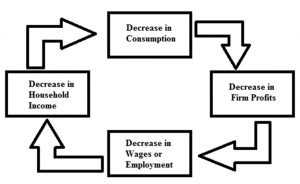We’ve all witnessed the political posturing. Democrats claim that the only way out of our economic malaise is to enact an FDR style economic stimulus. By contrast, the Republicans claim that stimulus doesn’t work efficiently and instead offer tax cuts. With all this posturing, it can be difficult to tell who is right.
The Democratic claim that an “expansionary fiscal policy,” or stimulus, will result in job growth is not incorrect. Certainly the reason the U.S. got out of the Great Depression was due to the massive government spending in the Second World War. At one level, their argument just makes sense. However, to truly understand the argument one needs to understand the economic theory.
The idea of stimulus is best explained by the British economist John Maynard Keynes. He argued that during a recession people consume less, which means companies make less, resulting in more layoffs and further decrease in consumption. Keynes argued that the only way to get out of a depression was to have the government launch an expansionary fiscal policy.
When this money entered the economy, the people getting it would spend most of it, and this would continue, making a chain of spending called the fiscal multiplier. This means that for every dollar that was put into the economy, ten might be spent, breaking the cycle and starting an economic recovery.
Given this theory, stimulus makes sense. However, the realm of theory is often radically different from reality. If stimulus actually works, why did the 2009 stimulus not result in an economic recovery?
Many on the left claim that the problem was that the stimulus was too small to work effectively. However, that is unlikely to be the case as economists using data from the White House have calculated that the stimulus cost $267,000 per job saved. This ties into the problem with stimulus, the fiscal multiplier. Stimulus only works when there is a sufficiently large fiscal multiplier.

Does this mean that the Republican’s plan is better? Unfortunately, no. The Republican plan can be summarized simply as tax cuts, which are just another form of expansionary fiscal policy. Economists usually agree that the fiscal multiplier from tax cuts is smaller than that of government spending, and the 2009 stimulus reflected that with very low multiplier rates on the tax cut portions.
Fiscal multipliers can be much higher, but because of poor planning they have been small. The principal reason that both the Democrat and Republican plans don’t work is that they have a critical flaw. They misanalyze the nature of the recession.
Keynes’ theory only works when the recession is caused by a lack of demand – that is not the problem in our economy. The problem is that there is too much debt. The economy will not really start growing again until the majority of that debt is paid off and citizens can start consuming again.
The reason the fiscal multiplier is so low is that people do not spend the money, they use it to pay off their debt. Thus, it is much harder to get out of a debt-based crisis, and it tends to take a lot longer. American households have been paying off their debt since the crisis, but it is still well over 100% of disposable personal income.
Until the parties recognize the true nature of our crisis, it is unlikely the economy will begin a real recovery. Unfortunately, neither party wants to accept that the economy doesn’t have an easy fix, and as such little is likely to be done.